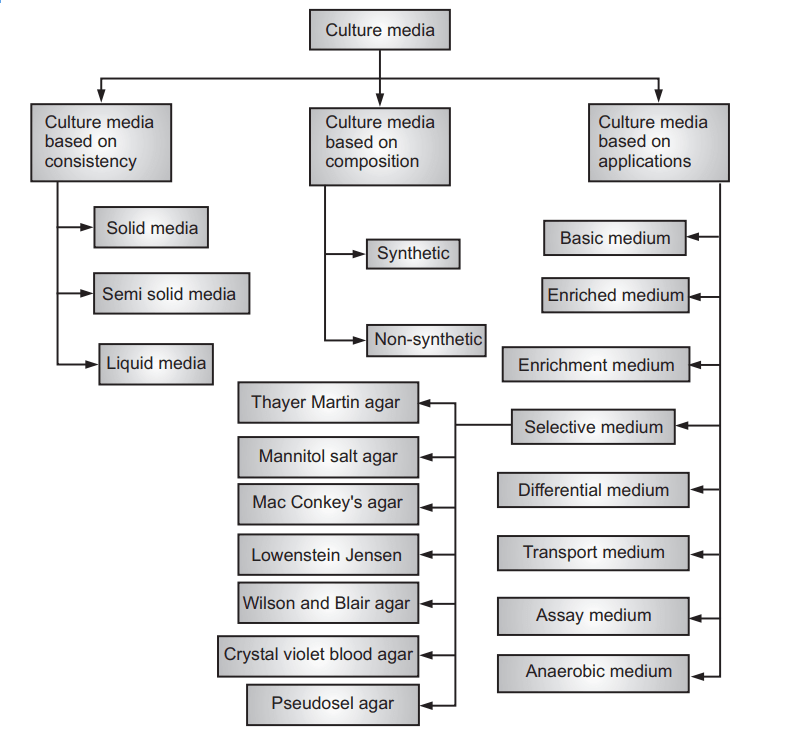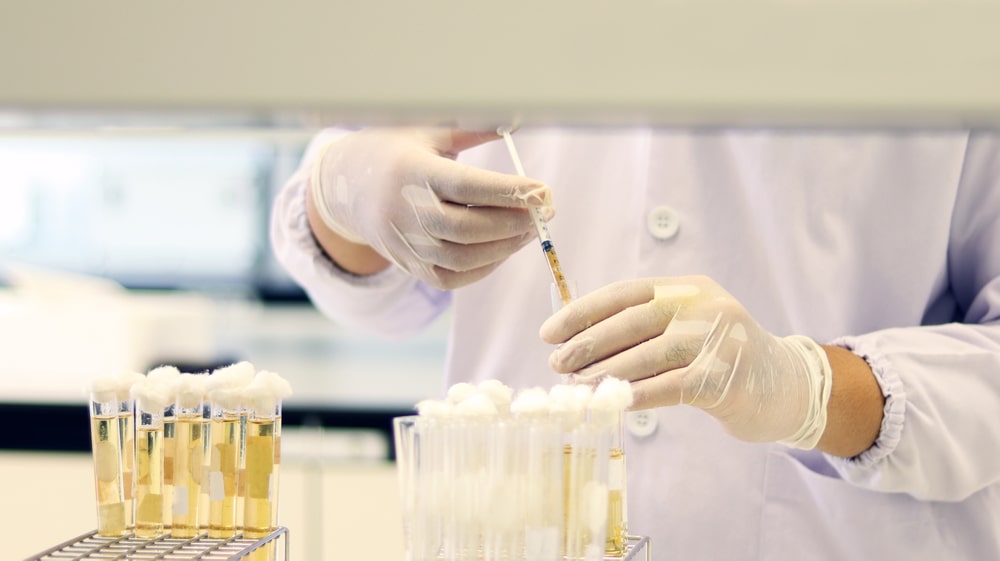Culture media are the base where microorganisms can grow with the help of nutrients and under the influence of physical growth parameters. All microorganisms cannot grow in a single culture medium and many cannot grow in any known culture medium. Some organisms that cannot grow in the artificial culture medium are known as obligate parasites. Examples: Mycobacterium leprae, Rickettsias, Chlamydias, Treponema pallidum.
Based on the consistent nature of the media, they are classified into solid, semi-solid, and liquid. Solid media contains agar (1.5-2.0%) as a solidifying agent and is suitable for the isolation of bacteria and determination of colony characteristics. Examples: Nutrient agar, BAP, etc. Semi-solid media also contains agar but the percentage content is less (0.5%). This media is useful for the determination of the motility of bacteria and the cultivation of microaerophilic bacteria. Liquid media that do not contain agar except for the required amount of nutrients. This media is useful for the propagation of a large number of organisms, fermentation studies, and various tests (Sugar fermentation test).
There are various types of culture media based on the applications as well as media compositions.
Table of Contents
Culture media classification:

The importance of culture medium is to grow microorganisms outside the body for some important applications such as:
- To identify the cause of infection from the clinical samples.
- To study the characteristics and properties of microorganisms.
- To prepare biological products like vaccines, antigens, toxoids, etc.
Composition of Culture Medium:
- Energy source
- Carbon source
- Nitrogen source
- Water
- Specific growth factors
- Mineral salts
Synthetic medium:
This medium is prepared from purified ingredients so that the whole composition of the medium is known. They are simple or complex, based on the supplements incorporated in the medium. A simple non-synthetic medium has all the nutrient requirements of organisms and some growth factors whereas a complex non-synthetic medium does not contain purified or completely characterized or constant consistency between their batches and this medium supports the growth of more fastidious microorganisms (has a complex nutritional requirement).
Example: Nutrient broth is derived from cultures of yeasts.
- General-purpose media/Basic media: Basal media are simple media that supports most non-fastidious bacteria and are used for the isolation of primary microorganisms. Peptone Water, nutrient broth, and nutrient agar are considered basal mediums.
- Enriched medium: Addition of extra nutrients in the basal medium in form of blood, serum, egg yolk, etc. to make the medium-enriched. They are used to grow nutritionally exacting bacteria. Examples: Blood agar, chocolate agar, etc.
- Selective and enrichment media: They are designed to inhibit unwanted contaminating bacteria and help to recover pathogens from a mixture of bacteria. Selective media are agar-based and enrichment media are liquid inconsistency. The addition of antibiotics, dyes, chemicals, alteration of pH, etc. and makes a medium selective.
They are of various types like:
- Thayer Martin Agar: It is used to recover N. gonorrhoeae; contains antibiotics; vancomycin, colistin, and nystatin.
- Mannitol salt agar and salt milk agar: They are used to recover S. aureus; contain 10% NaCl.
- Potassium tellurite: This medium is used to recover C. diphtheriae; contains 0.04% potassium tellurite.
- Mac Conkey’s Agar: It is used for Enterobacteriaceae members contains bile salt that inhibits commonly gram-positive bacteria.
- Pseudosel Agar or Cetrimide Agar: It is used to recover P. aeruginosa contains cetrimide (antiseptic agent).
- Crystal Violet Blood Agar: It is used to recover S. pyogenes containing 0.0002% crystal violet.
- Lowenstein Jensen: This medium is used to recover M. tuberculosis is made selective by incorporating malachite green.
- Wilson and Blair’s Agar: It is used for recovering S. Typhi is rendered selective by the addition of dye brilliant green.
Enrichment Culture Medium:
Enrichment medium is liquid media, used to increase the relative concentration of certain microorganisms in the culture before plating on solid selective medium. It is mainly used as a broth medium. Example: Selenite F broth, tetrathionate broth, alkaline peptone water are used to recover pathogens from fecal specimens.
Differential/Indicator Medium:
In this medium dyes, metabolic substrates, etc. are added so that the bacteria that utilize them appear as differently colored colonies. Such media are called differential media or indicator media. Differential media allow the growth of more than one microorganism but with morphologically distinguishable colonies.
Examples:
- Mannitol salts agar (mannitol fermentation = Gram-positive bacteria Staphylococcus aureus produces yellow colonies with yellow zones.
- Blood agar (various kinds of hemolysis i.e. α, β and γ hemolysis).
- Mac Conkey Agar (lactose fermenters, pink colonies whereas non-lactose fermenter produces pale or colorless colonies.
- TCBS (Vibrio cholera produces yellow colonies due to fermentation of sucrose).
Transport media: These media are used when a specimen cannot be cultured soon after collection. These media prevent drying (desiccation) of the specimen, maintain the pathogen to commensal ratio and inhibit the overgrowth of unwanted bacteria. Example: Cary Blair medium, Amie’s medium, Stuart’s medium, etc. Stuart’s and Amie’s media are semi-solid media inconsistencies. The addition of charcoal serves to neutralize inhibitory factors. Cary Blair transport medium is used to transport feces from suspected cholera patients. Pike’s medium is used to transport streptococci from throat specimens.
Anaerobic media: Anaerobic media is mainly supplemented with hemin and vitamin K where bacteria need low oxygen content, reduced oxidation-reduction potential, and extra nutrients for their growth. The media is also contained 1% glucose, 0.1% thioglycollate, 0.1% ascorbic acid, 0.05% cysteine or red hot iron filings. Before using the medium is to be boiled in a water bath to expel any dissolved oxygen and then sealed with sterile liquid paraffin. Example: Robertson Cooked Meat (RCM) medium is commonly used to grow Clostridium spps. contains a 2.5 cm column of bullock heart meat and 15 ml of nutrient broth. Thioglycollate broth contains sodium thioglycollate, glucose, cystine, yeast extract, and casein hydrolysate.
Assay Media: This media is used for the assay of amino acids, vitamins, and other antibiotics. Antibiotic assay media are used for the determination of antibiotic potency (by microbial assay).
Make sure you also check our other amazing Article on : Ultra Structure of Bacteria
